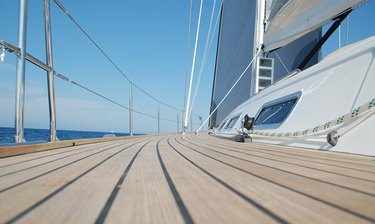
They are both lumber materials used for decorative and structural purposes, but teak and bamboo couldn't be more different, and the most obvious difference between teak vs. bamboo is the raw materials from which they are derived. Teak comes from a genus of trees in the mint family that grow in the tropical forests of Southeast Asia, whereas bamboo is a grass.
Bamboo lumber for flooring and construction purposes comes primarily from Phyllostachys edulis 'Moso' bamboo, which is native to China and grows large, hollow canes with diameters between 4 and 8 inches. The canes appear woody, but they are fibrous, and the fibers have to be processed into lumber using strong adhesives, whereas teak, like all woods, only has to be cut and milled.
Video of the Day
Video of the Day
Is Teak or Bamboo More Durable?
Among the factors that determine durability are rot resistance and ability to resist breaking, but the comparison you're most likely to make is hardness, or impact resistance. The test to measure hardness is called the Janka test, and wood species are rated on a scale of how much force it takes to compress a 1/2-inch steel ball halfway into the surface of a plank. Counterintuitively, virtually all types of bamboo lumber have higher Janka scores than teak unless you're talking about Brazilian teak, or cumaru, which grows in South America and isn't considered true teak.
Even as far as hardwoods go, true teak isn't very hard, scoring just over 1,000, which is less than most domestic hardwoods. Horizontal and vertical bamboo score over 1,700, and strand bamboo scores 4,600, which is at the top of the chart, scoring even higher than cumaru (3,540), ipé or Brazilian walnut (3,680) and even lignam vitae, which is seldom used because it's so difficult to work. It's the resins in the bamboo planks that confer this hardness, not the bamboo fibers themselves, but that doesn't matter if all you're looking for is a flooring material that won't dent.
Sustainability of Bamboo and Teak
Both teak and bamboo are grown on plantations, but the harvest time is vastly different. It takes a teak tree 25 to 30 years to mature to the point at which it's good for lumber, whereas a Moso bamboo stalk can grow at a rate of 3 feet per day and be ready for harvest five to six months after the shoots appear. Obviously, a bamboo plantation yields much more product than a teak plantation, which is why bamboo is usually characterized as a green (more sustainable) material.
The processing of bamboo lumber for use in flooring and construction isn't quite as green, however, because it consumes energy to separate the fibers and boil them until they are soft and to compress the fibers into lumber. The adhesives used to bind the strands into lumber aren't always the most environmentally friendly either depending on the manufacturer (most are in China) and the quality of flooring or lumber produced. Until recently, formaldehyde was a common ingredient in bamboo flooring adhesive, and some factories still use it.
Uses of Bamboo and Teak
Teak is too soft and expensive to be widely used for flooring, although it's a common decking material for boats because of its resistance to moisture and rot. More common uses for teak include furniture, especially outdoor furniture, as well as interior and exterior woodwork. Most processed bamboo lumber, on the other hand, is milled into flooring planks, although more and more is being used to manufacture dimensioned lumber for construction.
You can find furniture made of processed bamboo, but it doesn't have the resilience and beauty of teak, and because it's a processed material, it doesn't do well outside. Once moisture and sunlight degrade the surface of a bamboo plank, the plank is done; it can't be refinished and will only continue deteriorating. Teak, on the other hand, can last for decades in harsh conditions, and if you give it the proper care, it can maintain its original honey-brown coloration for almost as long.